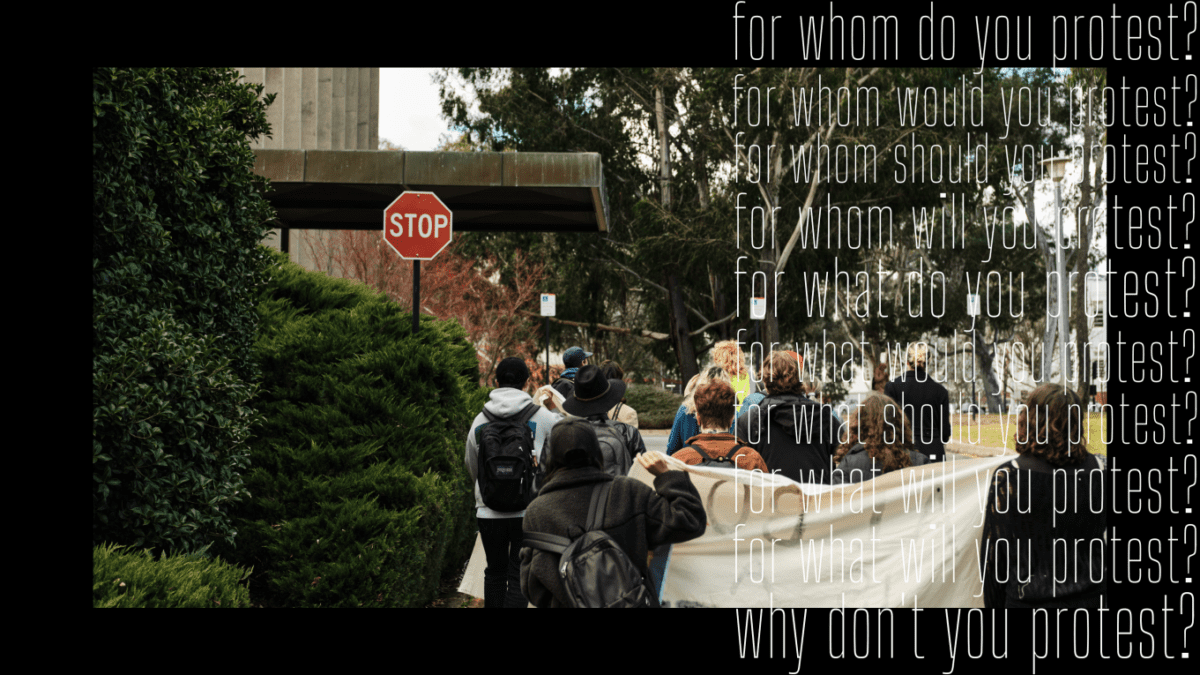At midday, on the 2nd of July, Garema Place was transformed into an amphitheatre.
A crowd of people had overflowed the square and arranged themselves to stand at attention to the amplified voice of protest – a marquee fitted with a PA system. The protesting assembly declared their intentions in the form of a forest of picket signs, disgusted by the overturn of Roe v. Wade. For the past fifty years the US Supreme Court’s landmark case has protected an individual’s right to choose.
The messages were varied in tone, but united in meaning; the cuttingly blunt and the mockingly witty.
“Abortion = Healthcare!” “Girls just want to have fundamental human rights!”
Approaching this scene, I was, for the first time, hit with the scale of the gathering. I wondered aloud who the intended audience of the demonstration was.
Surely, we weren’t seeking the attention of the offending American judiciary? Nor was our national government likely to be moved. Even supposing we did sway the heart of some MP, or an ACT Minister, what exactly did we expect them to do about the erosion of bodily autonomy in a country half-way around the world?
One of my companions knocked me out of my cynicism. She pointed out a pair of young girls, not older than five or six, accompanying their mother at the rally. One held a twig with a sheet of A4 paper taped to the end – a picket sign in miniature.
“There’s your audience.”
…
Packed into the square – steps and tables standing in for bleachers – we listened to a series of speeches. Topics ranged from the specific and horrific consequences of anti-abortion legislation, to the details of the Roe v. Wade decision, and strong calls for more radical and progressive reform in our own government. The style of the speakers also varied. The event saw touching personal storytelling, cautious optimism from veteran activists and firebrand oratory from the socialist contingent; all serving to unite and ignite the crowd with a potent mixture of outrage and hope.
At the close of the speeches, from somewhere within the audience, a drum started beating. We followed it, and our small armada of signs marched through Civic Square, the Legislative Assembly and the shopping centre. Loosely escorted by police, alternatively stoic and professional or enthusiastically supportive, we marched on the road. The slight sense of trespass and the disrupted traffic only added to our sense of importance and unity.
As the task of calling “What do we want?” and “When do we want it?” passed through the crowd like a baton, the accompanying “Abortion Rights!” and “Now!” echoed off the surrounding buildings; my mind turned again to who this was all for.
A week later, I don’t remember much of the speeches, nor do I remember those who gave them. What I do remember is their oratory skills and genuine passion for the cause. What I remember is the crowd. I remember when the speakers brought up some shameful statistics. I remember being appalled. And those around me shared my sentiment. When a story of strength or some progressive proposal was forwarded, I remember cheering – along with everybody else. I remember the beating of the drum, a bass note for our cries of support and denouncement.
In this way, by the fluctuations of hope and outrage, the consistency of our agreement, and the sense of group disobedience the assembly was turned from a collection of strangers to a unit with purpose. Group mentality, good versus evil, us and them; they’re old tricks, but undeniably effective.
…
A protest is a tool – like a crowbar or a chisel. It’s an instrument that works to effect change on a social system and its effectiveness, like any tool, depends both on the force generated by it, and the precision with which it is wielded. The elements that give a protest its force, how it generates and focuses the energy of its participants, are well studied, widely practiced, tried-and-true. But the matter of when and where to apply that energy, and who best to bring that force, these are open questions.
This is a solidarity march. In solidarity with a series of protests across the country – part of a larger demonstration as a warning to our own government. But this march is also for us, the marchers; in solidarity with one another. By gathering, marching, listening to speeches and making signs we reaffirm each other’s belief that reproductive rights are human rights, and that those rights are worth defending. We are all, in some way, those young girls; and we teach one another what their mother is teaching them – when our rights, our freedoms, and the principles we believe in come under attack, this is what we do.
Think your name would look good in print? Woroni is always open for submissions. Email write@woroni.com.au with a pitch or draft. You can find more info on submitting here.
We acknowledge the Ngunnawal and Ngambri people, who are the Traditional Custodians of the land on which Woroni, Woroni Radio and Woroni TV are created, edited, published, printed and distributed. We pay our respects to Elders past and present. We acknowledge that the name Woroni was taken from the Wadi Wadi Nation without permission, and we are striving to do better for future reconciliation.
